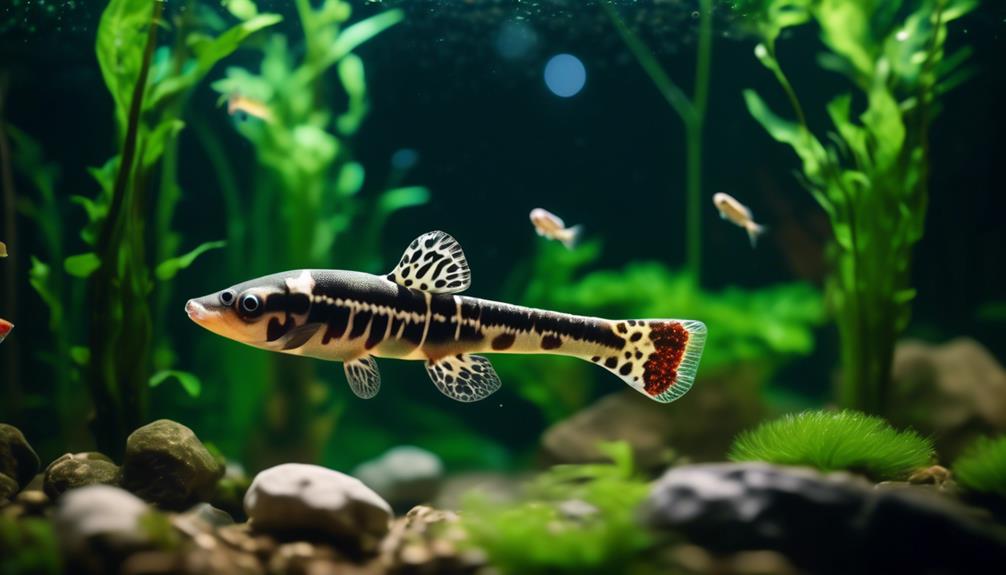Welcome to the intriguing world of Hillstream Loaches, a species of fish that possesses a remarkable talent for consuming algae. In this comprehensive guide, we will explore the distinctive characteristics of these fish, the ideal tank setup for their well-being, compatible tankmates, their dietary needs, and even tips on breeding them successfully.
From their streamlined shape and unique patterned bodies to their captivating behavior and feeding habits, Hillstream Loaches are truly fascinating creatures.
So, if you're curious to learn more about these unusual algae-eating fish and how to care for them, join us as we uncover the secrets of the Hillstream Loach Guide.
Key Takeaways
- Hillstream loaches have a unique appearance with a streamlined shape, flat underside, and horizontal fins that allow them to grip onto smooth surfaces.
- They are active during the daytime and can often be seen climbing on glass or fluttering their fins on the ground.
- Hillstream loaches are native to tropical regions of Vietnam, Laos, and Cambodia and can be kept in various tank setups, including river manifold tanks, unheated setups, and planted tanks.
- They are compatible with peaceful community fish of similar size and can be fed a variety of high-quality foods, including algae, sinking wafers, and frozen spirulina brine shrimp.
Characteristics and Behavior of Hillstream Loaches
Hillstream loaches, native to the tropical regions of Vietnam, Laos, and Cambodia, exhibit distinctive characteristics and behaviors that make them a fascinating addition to any aquarium. These fish have a streamlined shape and a flat underside resembling a miniature stingray. Their horizontal fins allow them to tightly grip onto smooth surfaces. Hillstream loaches have light-colored spots and dark brown striping patterns on their body. They are active during the daytime and can often be seen climbing on glass or fluttering their fins on the ground.
When it comes to their habitat and natural behavior, Hillstream loaches can be kept in various tank setups, including river manifold tanks, unheated setups, and planted tanks. It is important to maintain a stable pH (preferably 7.0-7.8) and good water quality. Any kind of fish tank filter can be used, as long as it is appropriately sized. The acceptable temperature range for Hillstream loaches is 65-80°F (20-27°C). To prevent escape, the aquarium hood or top should be tightly fitting.
In terms of care and maintenance tips, Hillstream loaches get along well with peaceful community fish of similar size. They are compatible with goldfish, livebearers, shrimp, snails, tetras, danios, and other schooling fish. However, it is important to avoid fish that may nip their fins. In case of insufficient cover in the tank, males may spar with each other. Providing more decorations or aquarium plants can help reduce aggression levels.
When it comes to their diet, Hillstream loaches consume small aquatic crustaceans, algae, and small organisms on underwater surfaces in the wild. In the aquarium, they scrape off algae from tank walls, rocks, driftwood, and plant leaves. It is also important to feed them a variety of high-quality foods such as Repashy gel food, sinking wafers, frozen spirulina brine shrimp, and blanched vegetables. Algae alone is not sufficient for their survival, and a well-fed diet increases the likelihood of breeding.
Setting Up the Perfect Aquarium for Hillstream Loaches
With a clear understanding of the characteristics and behavior of Hillstream loaches, it is essential to create an optimal aquarium environment that caters to their specific needs and ensures their well-being. When setting up the perfect aquarium for Hillstream loaches, it is important to consider two key factors: choosing the right tank decorations and maintaining water quality.
Hillstream loaches are adapted to fast-flowing streams, so mimicking their natural habitat in the aquarium is crucial. Opt for smooth rocks, driftwood, and artificial plants that provide hiding places and surfaces for algae growth. These decorations also aid in creating strong water currents, which are necessary for their well-being.
Water quality is of utmost importance for Hillstream loaches. Regular water changes, filtration, and monitoring of pH levels (preferably 7.0-7.8) are essential. A well-maintained aquarium ensures optimal health and reduces the risk of diseases. Additionally, providing good water quality contributes to the growth of algae, which is an important part of their diet.
Compatible Tankmates for Hillstream Loaches

When selecting tankmates for Hillstream loaches, it is important to choose peaceful community fish of similar size that will not nip their fins. Hillstream loaches can coexist harmoniously with a variety of species, including shrimp, livebearers, snails, tetras, danios, and other schooling fish. However, there are some potential challenges when keeping them with goldfish. Goldfish are known to be fin-nippers, which can cause stress and injury to the delicate fins of Hillstream loaches. Therefore, it is advisable to avoid keeping these two species together in the same tank. On the other hand, keeping Hillstream loaches with shrimp can be beneficial. Shrimp help to maintain a clean aquarium by consuming leftover food and algae. They also provide visual interest and add to the overall biodiversity of the tank. To summarize the compatibility of Hillstream loaches with different species, refer to the table below:
| Compatible Tankmates for Hillstream Loaches |
|---|
| Shrimp |
| Livebearers |
| Snails |
| Tetras |
| Danios |
| Other schooling fish |
Feeding Hillstream Loaches: Diet and Nutrition
To ensure the optimal health and well-being of Hillstream loaches, it is essential to understand their dietary requirements and provide them with a nutritious and balanced diet.
In the wild, Hillstream loaches consume small aquatic crustaceans, algae, and small organisms on underwater surfaces. In captivity, they scrape off algae from tank walls, rocks, driftwood, and plant leaves. However, algae alone is not sufficient for their survival.
It is important to supplement their diet with a variety of high-quality foods. These can include Repashy gel food, sinking wafers, frozen spirulina brine shrimp, and blanched vegetables.
A well-fed diet not only promotes their overall health but also increases the likelihood of breeding. Therefore, providing a diverse and nutritious diet is crucial for the success and well-being of Hillstream loaches.
Breeding Tips for Hillstream Loaches

Breeding Hillstream Loaches requires careful consideration of their specific environmental and dietary needs. Creating the optimal breeding tank conditions is crucial for successful breeding. Hillstream loach breeding techniques can be enhanced by providing the right environment and ensuring the availability of sufficient food for the adults and fry. Here are some tips to help you breed Hillstream Loaches:
| Optimal Breeding Tank Conditions | Breeding Tips |
|---|---|
| Water temperature: 68-75°F (20-24°C) | Use a mature, established tank |
| pH: 7.0-7.8 | Provide hiding spots and caves |
| Water hardness: 5-15 dGH | Include live plants for cover |
| Water flow: moderate to strong | Feed a varied, high-quality diet |
To increase the chances of successful breeding, it is recommended to have a group of six or more Hillstream Loaches, as sexing juveniles can be challenging. The presence of mulm, infusoria, algae, and hiding spots in the tank can promote breeding. It is essential to provide plenty of food for the adults and cover the filter intake to protect the fry. Feeding the fry with infusoria, vinegar eels, microworms, live baby brine shrimp, and powdered fry food can enhance their survival rate. Following these breeding tips will help you maintain a healthy and thriving population of Hillstream Loaches in your aquarium.
Frequently Asked Questions
Are Hillstream Loaches Suitable for Beginners or Experienced Fish Keepers?
Hillstream loaches are suitable for both beginners and experienced fish keepers. They have unique characteristics, such as their ability to eat algae, making them low-maintenance. They also have a wide range of compatible tankmates, adding to their appeal.
How Often Should the Tank Be Cleaned for Hillstream Loaches?
Maintaining water quality for hillstream loaches is crucial for their well-being. The tank should be cleaned regularly to remove excess waste and debris. A recommended frequency is once every two weeks, although it may vary depending on the tank size and stocking levels.
Can Hillstream Loaches Be Kept in a Community Tank With Aggressive Fish?
Hillstream loaches are generally compatible with peaceful community fish of similar size, but should be kept away from aggressive species. Regular tank maintenance is crucial to ensure their well-being and water quality.
Do Hillstream Loaches Require a Specific Type of Substrate in Their Tank?
Hillstream loaches do not require a specific type of substrate in their tank. However, they prefer a tank setup with smooth surfaces, such as rocks or smooth gravel, to mimic their natural habitat and allow them to grip on securely.
How Long Do Hillstream Loaches Typically Live in Captivity?
Hillstream loaches typically live for 5-10 years in captivity. Breeding success can be achieved by providing an established aquarium with appropriate food, hiding spots, and cover for fry. A varied diet is crucial for their dietary needs.
Conclusion
In conclusion, Hillstream Loaches are fascinating algae-eating fish known for their unique characteristics and behavior. They require a well-maintained tank setup with good water quality and a stable pH level.
When choosing tankmates, it is important to consider their compatibility and avoid fish that may nip their fins.
A well-rounded diet consisting of high-quality foods is crucial for their overall health. Breeding Hillstream Loaches requires careful consideration of the aquarium environment and providing sufficient food for the adults and fry.
As the saying goes, 'A healthy diet leads to a thriving breed.'

